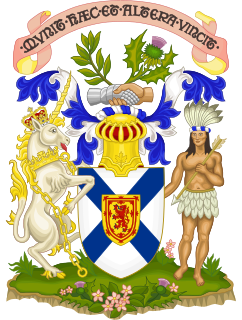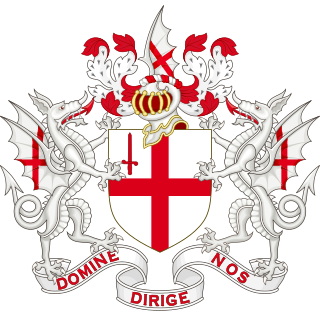
The coat of arms of Prince Edward Island was begun when the shield and motto in the achievement were granted in 1905 by royal warrant of the King Edward VII.

The coat of arms of Saskatchewan is the heraldic symbol representing the Canadian province of Saskatchewan.

A saltire, also called Saint Andrew's Cross or the crux decussata, is a heraldic symbol in the form of a diagonal cross, like the shape of the letter X in Roman type. The word comes from the Middle French sautoir, Medieval Latin saltatoria ("stirrup").

The coat of arms of Nova Scotia is the heraldic symbol representing the Canadian province of Nova Scotia. It is the oldest provincial achievement of arms in Canada, and the oldest British coat of arms in use outside Great Britain. It is blazoned as follows: Argent, a saltire azure charged with an escutcheon of the Royal Arms of Scotland.

The Senyera is a vexillological symbol based on the coat of arms of the Crown of Aragon, which consists of four red stripes on a yellow field. This coat of arms, often called bars of Aragon, or simply "the four bars", historically represented the King of the Crown of Aragon.

The coat of arms of Monaco, referred to also as an armorial achievement or an arms of dominion, is the symbolic representation of the House of Grimaldi, the current sovereigns of the principality of Monaco.

The Canadian Heraldic Authority is part of the Canadian honours system under the Canadian monarch, whose authority is exercised by the Governor General of Canada. The authority is responsible for the creation and granting of new coats of arms, flags, and badges for Canadian citizens, government agencies, municipal, civic and other corporate bodies. The authority also registers existing armorial bearings granted by other recognized heraldic authorities, approves military badges, flags, and other insignia of the Canadian Forces, and provides information on heraldic practices.

The coat of arms of Cape Town is the traditional symbol of the municipality of Cape Town. The original arms from the 20th century are no longer in official use, though no new arms have yet been adopted.

The flag of the Valencian Community and of the city of Valencia, known as Reial Senyera, is the traditional Senyera, composed of four red bars on a yellow background, crowned with a blue strip party per pale next to the hoist with 1/4 of the total length. It was adopted on 1 July 1982.

The Coat of arms of Balearic Islands is described in the Spanish Law 7 of November 21, 1984, the Law of the coat of arms of the Autonomous Community of Balearic Islands. Previously, by Decree of the Interinsular General Council of August 7 and 16, 1978, adopted the coat of arms as official symbol of the Balearic Islands.

The coat of arms of the Extremadura is described in the Title I of the Spanish Law 4 of June 3, 1985, the Law of the coat of arms, flag and regional day of Extremadura.

The so-called Bars of Aragon, Royal sign of Aragon, Royal arms of Aragon, Four Bars, Red Bars or Coat of arms of the Crown of Aragon, which bear four red pallets on gold background, depicts the familiar coat of the Kings of Aragon. It differs from the flag because this latter uses fesses. It is one of the oldest coats of arms in Europe dating back to a seal of Raymond Berengar IV, Count of Barcelona and Prince of Aragon, from 1150.

The Valencian Community is an autonomous community of Spain. It is the fourth most populous Spanish autonomous community after Andalusia, Catalonia and Madrid with more than five million inhabitants. Its homonymous capital Valencia is the third largest city and metropolitan area in Spain. It is located along the Mediterranean coast on the east side of the Iberian Peninsula. It borders with Catalonia to the north, Aragon and Castilla–La Mancha to the west, and Murcia to the south. The Valencian Community consists of three provinces which are Castellón, Valencia and Alicante.

German heraldry is the tradition and style of heraldic achievements in Germany and the Holy Roman Empire, including national and civic arms, noble and burgher arms, ecclesiastical heraldry, heraldic displays and heraldic descriptions. German heraldic style is one of the four major broad traditions within European heraldry and stands in contrast to Gallo-British, Latin and Eastern heraldry, and strongly influenced the styles and customs of heraldry in the Nordic countries, which developed comparatively late. Together, German and Nordic heraldry are often referred to as German-Nordic heraldry.

The coat of arms of the City of London is the official coat of arms of the City of London, which is one of a number of cities and boroughs in Greater London.
A national coat of arms is a symbol which denotes an independent state in the form of a heraldic achievement. While a national flag is usually used by the population at large and is flown outside and on ships, a national coat of arms is normally considered a symbol of the government or the head of state personally and tends to be used in print, on armorial ware, and as a wall decoration in official buildings. The royal arms of a monarchy, which may be identical to the national arms, are sometimes described as arms of dominion or arms of sovereignty.

The Eagle of Saint John is a heraldic eagle associated mostly with the Catholic Monarchs which was later prominently used during Francoist Spain (1939–77) and the Spanish transition to democracy (1977–81). It is sable with an or halo and feet of gules.

The coat of arms of the Castilla–La Mancha is described in the Spanish Law 1 of 30 June 1983, the Law of the coat of arms of Castilla-La Mancha Region and further regulated by Decree 132 of 5 July 1983, approving the official design of the coat of arms of Castilla-La Mancha and Decree 115 of 12 November 1985, supplementing Decree 132/1983.

The coat of arms of Barcelona is the official emblem of the City Council of Barcelona, the capital of Catalonia, has its origin in the Middle Ages, these arms were first documented in 1329. The Government of Catalonia conferred the coat of arms and the flag as official symbols of the municipality in 2004. It has an escutcheon in lozenge which is commonly used in municipal coats of arms of cities in Catalonia. Currently the City Council of Barcelona also uses an isotype based on the heraldry of the city.

The coat of arms of Castile was the heraldic emblem of its monarchs. Historian Michel Pastoureau says that the original purpose of heraldic emblems and seals was to facilitate the exercise of power and the identification of the ruler, due to what they offered for achieving these aims. These symbols were associated with the kingdom, and eventually also represented the intangible nature of the national sentiment or sense of belonging to a territory.



















